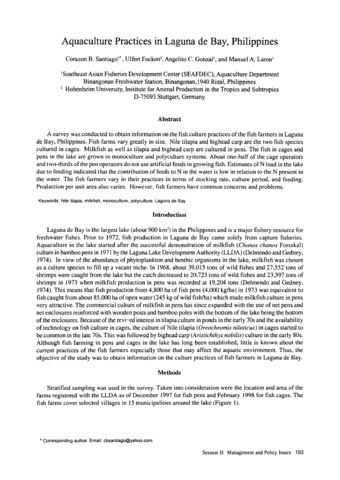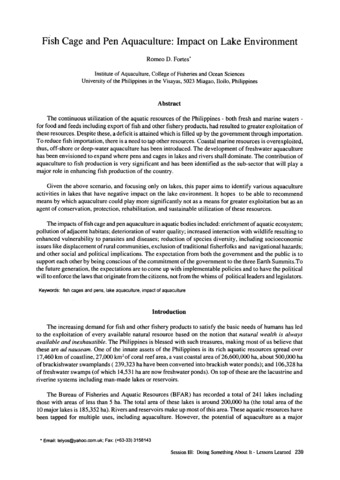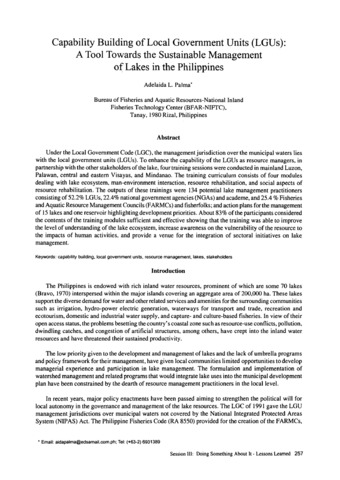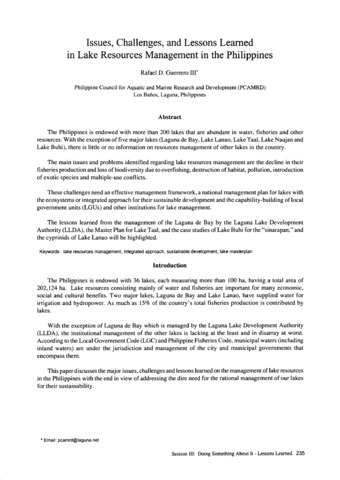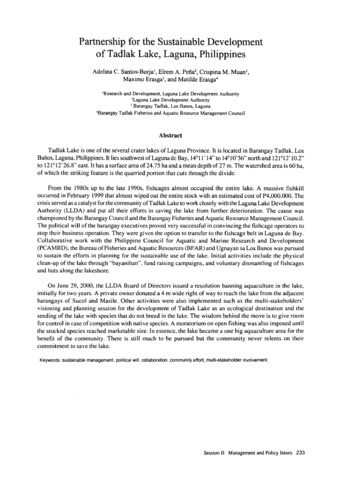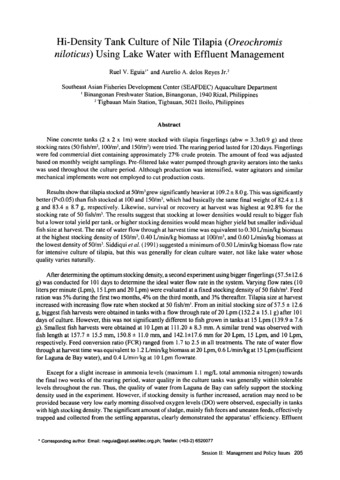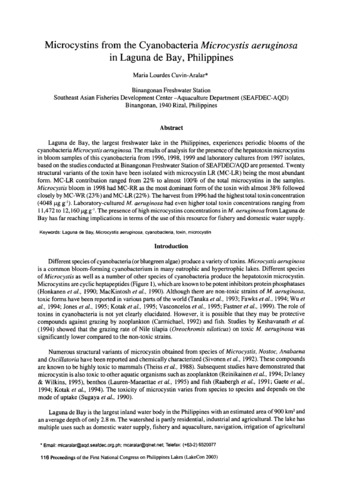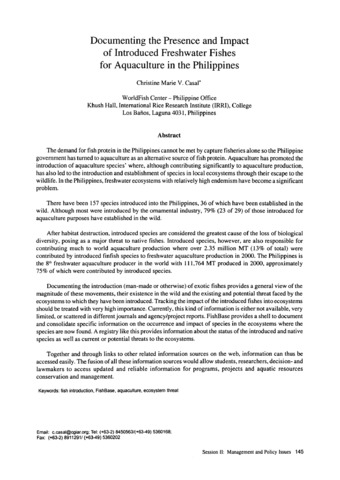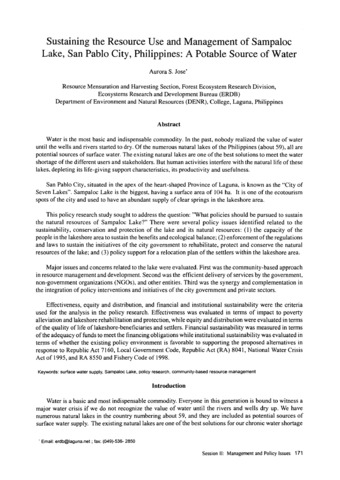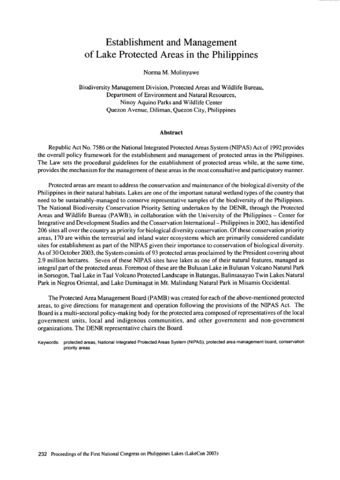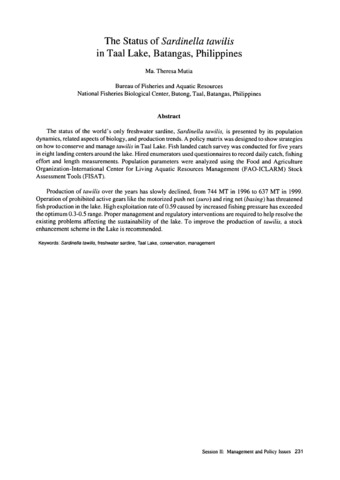Browsing SEAFDEC/AQD-Southeast Asian Regional Center for Graduate Study and Research in Agriculture (SEARCA) by Issue Date
Now showing items 1-20 of 49
-
Proceedings of the First National Congress on Philippine Lakes
(Southeast Asian Regional Center for Graduate Study and Research in Agriculture (SEARCA), 2005)The interconnectivity of land and water ecosystems and the uniqueness of lakes render lake management and conservation a very complex task. This is worsened by the predictable increasing demand for water and the continuing ... -
Integrated water resources management: the experience of Laguna Lake Development Authority (LLDA), Philippines
(Southeast Asian Regional Center for Graduate Study and Research in Agriculture (SEARCA), 2005)Laguna de Bay is the largest inland body of water in the Philippines and one of the largest lakes in Southeast Asia. The lake and its watershed, technically referred to as the Laguna de Bay Region or Basin, encompasses the ... -
Successful translocation of mountain Lake Makuwaw with sinarapan (Mistichthys luzonensis), the "world's smallest commercial fish"
(Southeast Asian Regional Center for Graduate Study and Research in Agriculture (SEARCA), 2005)Some 75,000 pieces of live sinarapan (Mistichthys luzonensis) individuals were transferred to mountain Lake Makuwaw in San Ramon, Buhi, Camarines Sur in January to May 2001. Before the fish transfers, the lake was chosen ... -
Aquaculture practices in Laguna de Bay, Philippines
(Southeast Asian Regional Center for Graduate Study and Research in Agriculture (SEARCA), 2005)A survey was conducted to obtain information on the fish culture practices of the fish farmers in Laguna de Bay, Philippines. Fish farms vary greatly in size. Nile tilapia and bighead carp are the two fish species cultured ... -
Fish cage and pen aquaculture: Impact on lake environment
(Southeast Asian Regional Center for Graduate Study and Research in Agriculture (SEARCA), 2005)The continuous utilization of the aquatic resources of the Philippines - both fresh and marine waters -for food and feeds including export of fish and other fishery products, had resulted to greater exploitation of these ... -
Pansipit river rehabilitation program, Batangas, Philippines
(Southeast Asian Regional Center for Graduate Study and Research in Agriculture (SEARCA), 2005)In the early 1990s, fish cages were established in Pansipit River, the only outlet from Taal Lake going to Balayan Bay, Batangas, Philippines. This resulted to the clogging of water current and population decline of marine ... -
Investigation of massive fish kill in Lake Buhi, Camarines Sur, Philippines
(Southeast Asian Regional Center for Graduate Study and Research in Agriculture (SEARCA), 2005)Lake Buhi is a multi-species fishery resource and known worldwide for being the home of the world s smallest commercial fish (Mistichthys luzonensis). The lake is used for fishery, agriculture, irrigation, hydroelectric ... -
Capability building of Local Government Units (LGUs): A tool towards the sustainable management of lakes in the Philippines
(Southeast Asian Regional Center for Graduate Study and Research in Agriculture (SEARCA), 2005)Under the Local Government Code (LGC), the management jurisdiction over the municipal waters lies with the local government units (LGUs). To enhance the capability of the LGUs as resource managers, in partnership with the ... -
Issues, challenges, and lessons learned in lake resources management in the Philippines
(Southeast Asian Regional Center for Graduate Study and Research in Agriculture (SEARCA), 2005)The Philippines is endowed with more than 200 lakes that are abundant in water, fisheries and other resources. With the exception of five major lakes (Laguna de Bay, Lake Lanao, Lake Taal, Lake Naujan and Lake Buhi), there ... -
Partnership for the sustainable development of Tadlak Lake, Laguna, Philippines
(Southeast Asian Regional Center for Graduate Study and Research in Agriculture (SEARCA), 2005)Tadlak Lake is one of the several crater lakes of Laguna Province. It is located in Barangay Tadlak, Los Banos, Laguna, Philippines. It lies southwest of Laguna de Bay, 14°11 14 to 14°10 56 north and 121° 12 10.2 to ... -
Fishes of Laguna de Bay in the Philippines: Status and research gaps for conservation using FishBase
(Southeast Asian Regional Center for Graduate Study and Research in Agriculture (SEARCA), 2005)FishBase is the world s premier database on fishes with key information on more than 27,800 species. A review of FishBase indicates that the fish fauna of Laguna de Bay consists of 31 species belonging to 18 families. Three ... -
Hi-density tank culture of Nile tilapia (Oreochromis niloticus) using lake water with effluent management
(Southeast Asian Regional Center for Graduate Study and Research in Agriculture (SEARCA), 2005)Nine concrete tanks (2 x 2 x 1 m) were stocked with tilapia fingerlings (abw = 3.3±0.9 g) and three stocking rates (50 fish/m2, 100/m2, and 150/m2) were tried. The rearing period lasted for ... -
Microcystins from the cyanobacteria Microcystis aeruginosa in Laguna de Bay, Philippines
(Southeast Asian Regional Center for Graduate Study and Research in Agriculture (SEARCA), 2005)Laguna de Bay, the largest freshwater lake in the Philippines, experiences periodic blooms of the cyanobacteria Microcystis aeruginosa. The results of analysis for the presence of the hepatotoxin microcystins in bloom ... -
Socio-ecological case study of Lake Danao, Ormoc City, Philippines: Implications to management and policy
(Southeast Asian Regional Center for Graduate Study and Research in Agriculture (SEARCA), 2005)This paper discusses some of the social, political, and economic pressures impinging upon the ecosystem components of Lake Danao in Ormoc City, Philippines. Conflicting objectives among individual residents and various ... -
Documenting the presence and impact of introduced freshwater fishes for aquaculture in the Philippines
(Southeast Asian Regional Center for Graduate Study and Research in Agriculture (SEARCA), 2005)The demand for fish protein in the Philippines cannot be met by capture fisheries alone so the Philippine government has turned to aquaculture as an alternative source of fish protein. Aquaculture has promoted the introduction ... -
Sustaining the resource use and management of Sampaloc Lake, San Pablo City, Philippines: A potable source of water
(Southeast Asian Regional Center for Graduate Study and Research in Agriculture (SEARCA), 2005)Water is the most basic and indispensable commodity. In the past, nobody realized the value of water until the wells and rivers started to dry. Of the numerous natural lakes of the Philippines (about 59), all are potential ... -
Prawn fisheries of Lake Bato
(Southeast Asian Regional Center for Graduate Study and Research in Agriculture (SEARCA), 2005)Lake Bato is one of the most important lakes in the Bicol Region in terms of economic benefits to lakeshore communities. It is considered a commercial fishing ground of endemic and indigenous fish species. However, fish ... -
Protein-degrading bacteria in the sediments of caged and uncaged sites of Lake Taal, Batangas, Philippines
(Southeast Asian Regional Center for Graduate Study and Research in Agriculture (SEARCA), 2005)The populations of protein-degrading bacteria in the sediments of caged (Leviste, Laurel) and uncaged sites (Quiling, Talisay) in Lake Taal were determined by means of the most probable number (MPN) enumeration using ... -
Establishment and management of lake protected areas in the Philippines
(Southeast Asian Regional Center for Graduate Study and Research in Agriculture (SEARCA), 2005)Republic Act No. 7586 or the National Integrated Protected Areas System (NIPAS) Act of 1992 provides the overall policy framework for the establishment and management of protected areas in the Philippines. The Law sets the ... -
The status of Sardinella tawilis in Taal Lake, Batangas, Philippines
(Southeast Asian Regional Center for Graduate Study and Research in Agriculture (SEARCA), 2005)The status of the world s only freshwater sardine, Sardinella tawilis, is presented by its population dynamics, related aspects of biology, and production trends. A policy matrix was designed to show strategies on how to ...




